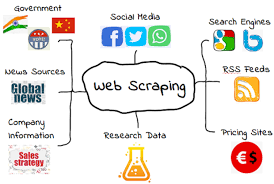HTML, CSS, and JavaScript are fundamental web technologies that play a crucial role in data scraping. Understanding these technologies is essential for effectively scraping and interacting with web pages. Here’s a brief overview of each:
- HTML (Hypertext Markup Language):
HTML is the standard markup language used for creating the structure and content of web pages. It defines the elements and tags that structure the page and represent different types of content, such as headings, paragraphs, images, links, tables, and forms. HTML provides the foundation for data scraping because it allows you to identify and locate specific data elements within a web page’s structure. - CSS (Cascading Style Sheets):
CSS is a stylesheet language that is used to describe the presentation and styling of a web page. It allows you to control the layout, colors, fonts, and other visual aspects of HTML elements. CSS selectors and properties are essential for targeting specific elements during data scraping. By understanding CSS, you can identify the elements or classes that contain the data you want to extract. - JavaScript:
JavaScript is a powerful scripting language that enables interactivity and dynamic behavior on web pages. When it comes to data scraping, JavaScript can be used to interact with the page, manipulate the DOM (Document Object Model), and extract data that may not be directly accessible through HTML or CSS. With JavaScript, you can perform actions like clicking buttons, scrolling, making AJAX requests, or dynamically modifying the page content to retrieve the desired data.
Data scraping typically involves inspecting the HTML structure of a web page, identifying the relevant data elements using HTML tags and CSS selectors, and using JavaScript (if necessary) to interact with the page and extract the data. Tools and libraries like BeautifulSoup (Python), Puppeteer (JavaScript), or Scrapy (Python) can aid in the scraping process by providing convenient methods and APIs for parsing HTML, selecting elements, and automating interactions.
It’s worth noting that some websites employ techniques like dynamic rendering, AJAX, or client-side rendering frameworks that require more advanced scraping techniques. However, having a solid foundation in HTML, CSS, and JavaScript will provide you with the necessary skills to navigate and extract data from a wide range of web pages.
